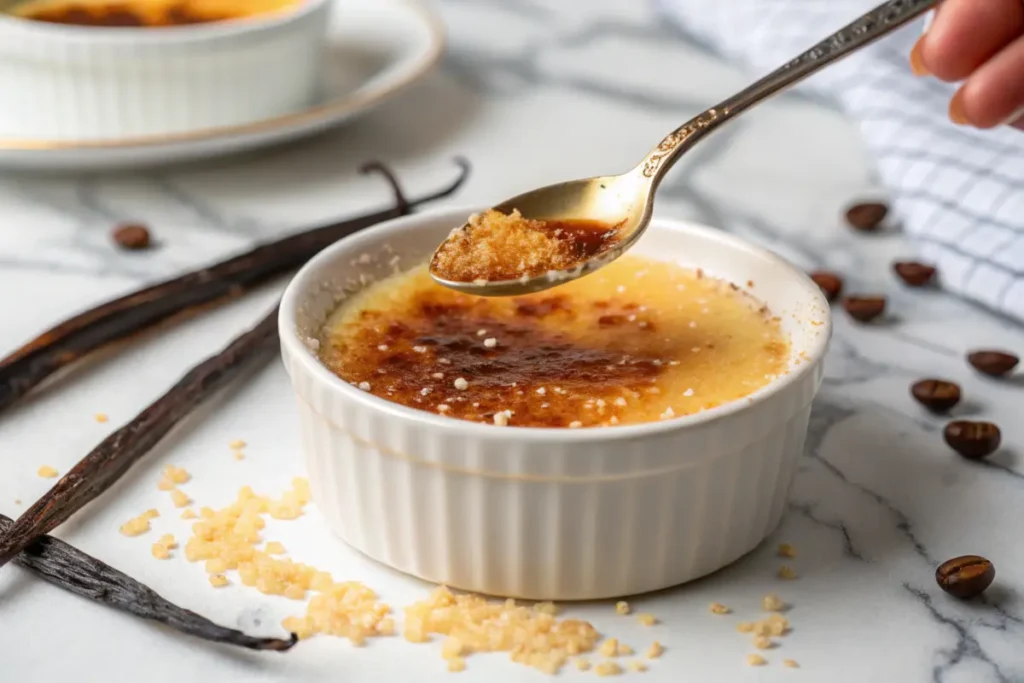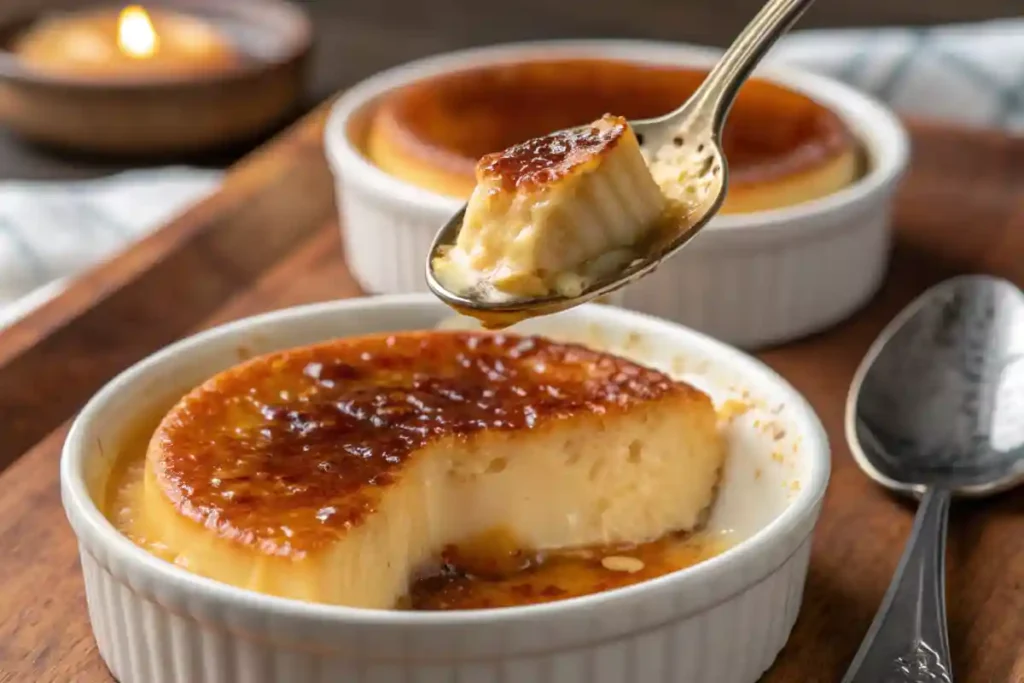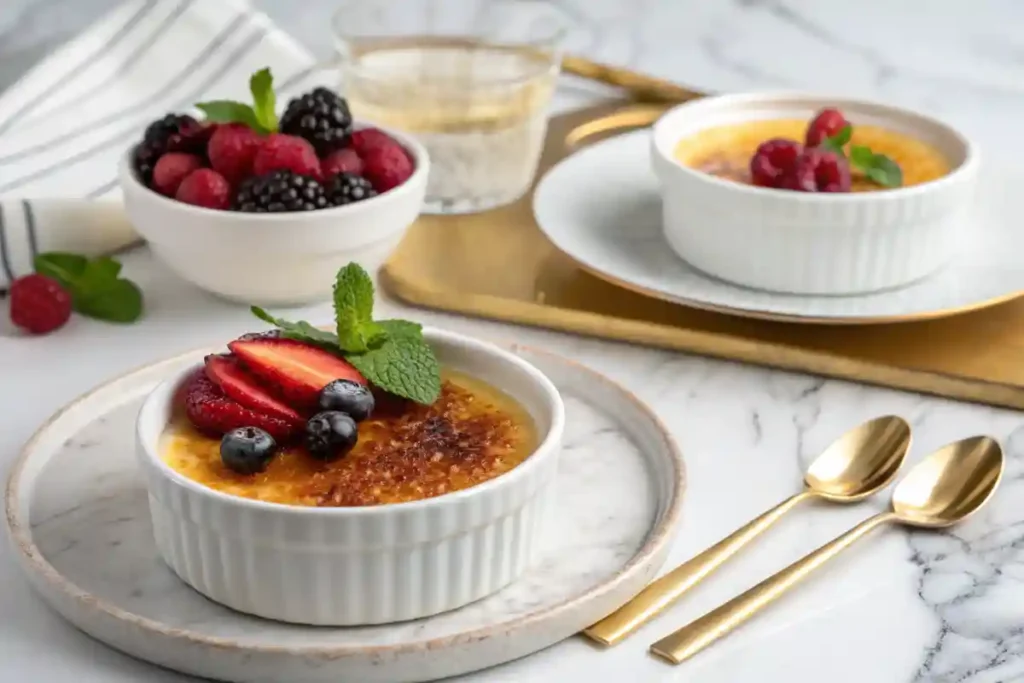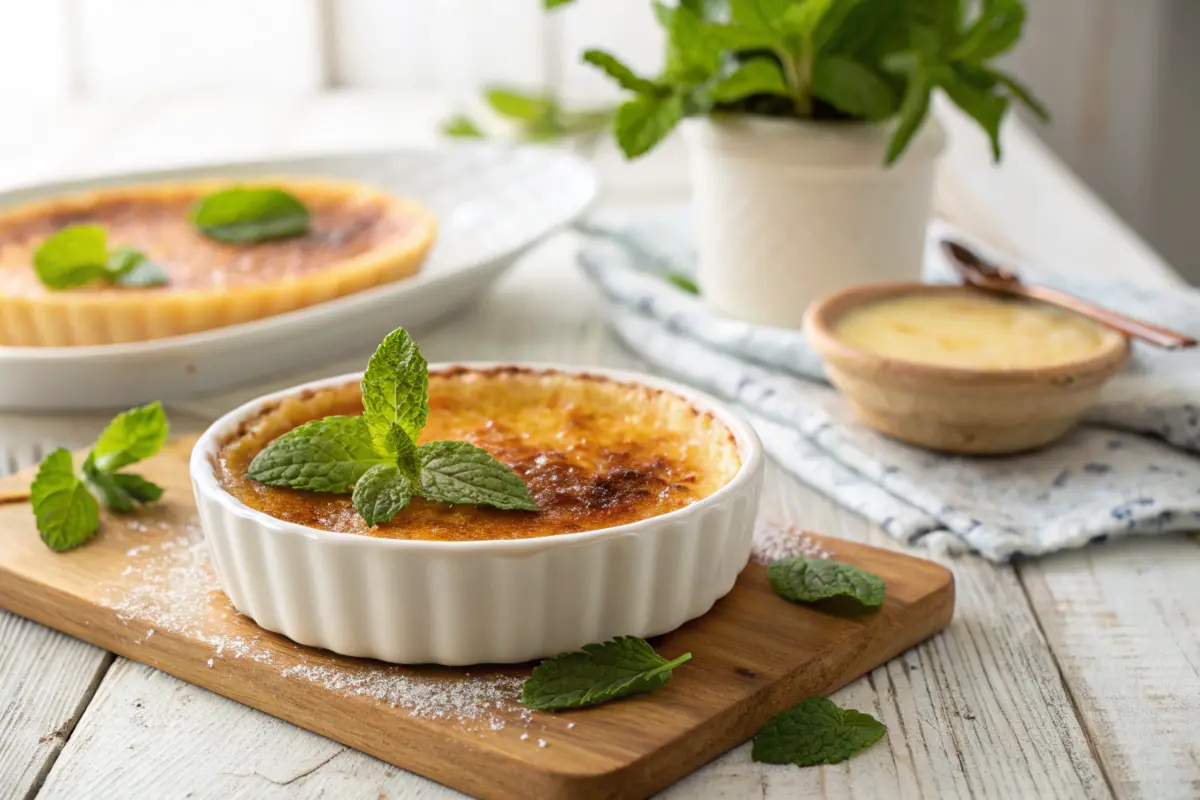When it comes to desserts, few are as universally loved as custard and crème brûlée. Both boast a creamy texture and sweet flavor that make them favorites worldwide. However, they aren’t as similar as they might seem at first glance. From their ingredients and preparation methods to their historical origins, crème brûlée and custard have distinct characteristics that set them apart.
In this article, we’ll explore the key differences between the two, diving into their ingredients, textures, and unique features. We’ll also touch on their rich histories, versatility in the kitchen, and tips for making them at home. Let’s break it all down, starting with the basics.
Understanding the Basics
What is Custard?
Custard is a beloved dessert that serves as a base for countless sweet and savory dishes. At its core, custard is a mixture of milk, cream, eggs, and sugar. The defining characteristic of custard is its texture, achieved by the coagulation of egg proteins during cooking.
- Key Ingredients and Types
Custards can vary widely based on their use and regional influences. Some are thickened entirely with eggs, while others might use a starch like flour or cornstarch for added body. Popular types include:- Baked custards: These are firmer and include dishes like flan and crème caramel.
- Stirred custards: Often softer and used as sauces or fillings, such as pastry cream.
- Culinary Applications
Custards shine as standalone desserts or as components in pies, tarts, and trifles. Their smooth, creamy texture is universally appealing, making them a versatile addition to any culinary repertoire.
What is Crème Brûlée?
Crème brûlée, which translates to “burnt cream” in French, is a dessert that combines a rich custard base with a crunchy, caramelized sugar topping. Its luxurious texture and dramatic presentation make it a staple of fine dining menus worldwide.
- Ingredients and Signature Features
The custard base of crème brûlée is typically made with heavy cream, egg yolks, sugar, and vanilla. The standout feature? The crisp layer of caramelized sugar on top, achieved by sprinkling sugar and torching it until golden brown. - Why It’s Unique
Crème brûlée is celebrated not just for its taste but also for the contrast between its velvety custard and brittle caramel topping. Breaking through that golden crust with a spoon is as satisfying as its taste!
Key Differences Between Crème Brûlée and Custard

Ingredients Comparison
At the heart of the question, “What’s the difference between crème brûlée and custard?”, are their ingredients. Both rely on a mixture of eggs, sugar, and dairy, but the proportions and types of dairy set them apart.
- Crème Brûlée: This dessert uses a rich blend of heavy cream and egg yolks, giving it a velvety texture. Vanilla extract or vanilla beans are often added for a fragrant flavor.
- Custard: Custard is more versatile, often made with milk or a mix of milk and cream. It uses either whole eggs or egg yolks, depending on the recipe.
While crème brûlée is inherently richer due to its high cream content, custards can range from light to luxurious, depending on how they’re prepared.
Texture and Consistency

The texture of crème brûlée and custard also highlights their differences.
- Crème Brûlée: Its baked custard base is smooth and dense, almost like silk. The caramelized sugar topping adds a delightful crunch, creating a contrast of textures.
- Custard: Custards vary widely in texture. Baked custards, like flan, are firmer and can hold their shape. Stirred custards, such as pastry cream, are creamy and spoonable.
These differences mean that while both desserts are creamy, crème brûlée feels more indulgent, and custards can be tailored to suit a variety of dishes.
Preparation Techniques
The methods used to prepare these desserts further separate them.
- Crème Brûlée: The custard base is baked in a water bath to ensure even cooking and a silky texture. Once cooled, a thin layer of sugar is added on top and caramelized with a kitchen torch or broiler. This step is what transforms custard into crème brûlée.
- Custard: Custards can be baked, stirred on the stovetop, or even steamed. Baked custards require careful attention to avoid cracking, while stirred custards demand constant stirring to prevent curdling.
These techniques highlight the artistry involved in creating both desserts and why crème brûlée is considered more elaborate.
Origins and Culinary History
Historical Background of Custards
Custards have been a staple in European cooking for centuries. The earliest recipes date back to the Middle Ages, where they were used as fillings for pies. Over time, custards evolved into standalone dishes, with variations appearing across cultures. From British custard tarts to French crème caramel, the versatility of custard has made it a global favorite.
Evolution of Crème Brûlée
Crème brûlée’s origins are often attributed to France, but its history is debated. Some believe it originated in England as “burnt cream,” while others trace it to Spain’s crema catalana. What sets crème brûlée apart is its modern refinement in French cuisine, where it became synonymous with luxury dining.
Its unique preparation, involving a caramelized sugar topping, became a hallmark of elegance. Today, it’s a dessert that signifies sophistication, often served at high-end restaurants or during special occasions.
Crème brûlée’s story, intertwined with the broader history of custards, showcases the adaptability of these desserts. Each has carved its place in culinary traditions, offering variations to suit every palate.
Versatility and Uses
Custards in Everyday Cooking
Custards aren’t just for dessert—they’re culinary multitaskers! Whether you’re whipping up a sweet treat or a savory dish, custard adds a creamy, indulgent touch. It’s a key ingredient in pies, tarts, and even quiches. Stirred custards, like pastry cream, are perfect for filling éclairs, profiteroles, and cakes.
When used in savory dishes, such as quiche or soufflé, the addition of herbs, cheese, or vegetables transforms custard into a hearty meal. For everyday cooking, it’s easy to make basic custard from scratch with just milk, eggs, and sugar, or experiment with more complex recipes.
For more inspiration, check out our guide to custard recipes on Recipe Foodies.
Crème Brûlée’s Place in Fine Dining
When it comes to crème brûlée, it’s all about presentation. This dessert is a star at upscale restaurants, thanks to its silky custard base and dramatic caramelized topping. The crisp sugar layer, cracked with a spoon, never fails to impress diners.
Beyond its classic form, crème brûlée can be flavored with chocolate, coffee, or fruit purees to add variety. Served in ramekins with artistic garnishes, it elevates any meal into a gourmet experience. Crème brûlée is undoubtedly a showstopper for dinner parties or romantic evenings at home.
Expert Tips for Home Chefs
Perfecting the Custard Base
Getting a smooth, velvety custard isn’t as hard as it seems, but it does take some finesse. First, always whisk your eggs and sugar thoroughly before adding the milk or cream. For the best texture, heat the milk gently before mixing it in—this prevents curdling.
Another tip? Use a fine mesh strainer to remove any lumps or bits of cooked egg. This simple step ensures a silky finish, whether you’re making a basic custard, pastry cream, or crème brûlée. Lastly, bake custards in a water bath to distribute heat evenly and avoid cracking.
Getting the Ideal Crème Brûlée Crust
Creating the perfect caramelized topping is all about timing and technique. Start by spreading a thin, even layer of sugar over the custard. For the best results, use a kitchen torch to caramelize the sugar—it gives you precise control and prevents the custard from overheating.
If you don’t have a torch, broil the crème brûlée briefly in the oven. Watch it closely to avoid burning the sugar. The key is to aim for a golden-brown crust that cracks satisfyingly when tapped with a spoon.
Whether you’re a seasoned chef or a beginner, these tips will elevate your custards and help you master the art of crème brûlée.
Final Thoughts and FAQs Section
FAQs Section: Revisiting Key Points
What’s the difference between crème brûlée and custard?
At their core, crème brûlée is a type of custard, but its signature caramelized topping and richer ingredients set it apart. While custards are versatile and found in both sweet and savory dishes, crème brûlée is a dessert centerpiece, celebrated for its contrasting textures.
Can you use custard for crème brûlée?
Yes, but with adjustments. Crème brûlée requires a richer base, usually with more cream and egg yolks, and the iconic sugar topping.
Are custards always sweet?
Not at all! Custards can be savory, like in quiches or soufflés, showcasing their adaptability.
Which dessert is easier to make?
Custards are generally simpler, as crème brûlée’s caramelized topping requires extra tools and care.
With this knowledge, you’re ready to try your hand at both desserts. Start small with custard and work up to the theatrical flair of crème brûlée. For a deeper dive into dessert techniques, explore more recipes and tips. Happy cooking!
Pairing and Serving Suggestions

How to Serve Custards
Custards are wonderfully versatile, making them a delight to serve in creative ways. For a simple treat, enjoy them warm or chilled with a sprinkle of nutmeg or cinnamon. Pair baked custards like flan with caramel sauce for a decadent finish.
When it comes to stirred custards, they shine as toppings or fillings. Use them in trifles, pour over fresh fruit, or serve alongside cakes and pies. To add flair, garnish with berries, mint leaves, or a drizzle of chocolate sauce.
Elevating Crème Brûlée Presentations
Crème brûlée is all about sophistication. To elevate its presentation, serve it in individual ramekins with a caramelized crust that glistens under candlelight. Pair it with a glass of dessert wine, like Sauternes, to complement its creamy texture and rich flavor.
For added creativity, infuse the custard base with flavors like lavender, matcha, or citrus zest. Garnish with edible flowers or a touch of whipped cream for an eye-catching finish. Whether served at a dinner party or a quiet night in, crème brûlée never fails to impress.
By exploring these serving options, you can create memorable dining experiences with both custards and crème brûlée, making every occasion special.
Wrapping Up the Sweet Debate
What’s the Difference Between Crème Brûlée and Custard?
To summarize, the main difference between crème brûlée and custard lies in their preparation and presentation. Crème brûlée is a type of custard, but its rich cream base and caramelized sugar topping give it a distinct identity. Custards, on the other hand, are a broader category of dishes that range from simple puddings to elegant flans.
Understanding these differences helps you appreciate the versatility of custard-based desserts while also recognizing what makes crème brûlée so special.
Why Both Deserve a Place in Your Recipe Repertoire
Custards and crème brûlée are both culinary classics that deserve a spot in your kitchen. Custards are approachable and adaptable, suitable for both sweet and savory dishes. Crème brûlée, with its unique flair, is perfect for impressing guests or treating yourself to a fancy dessert.
So, whether you’re a beginner or an experienced chef, there’s always a way to enjoy these timeless desserts. Explore their endless variations and let your creativity shine!

